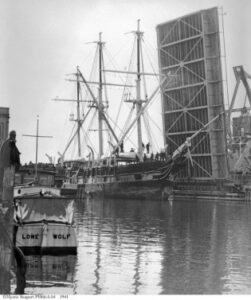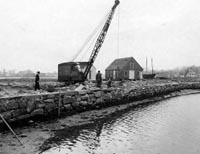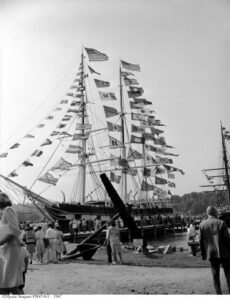The 1940s saw the momentous arrival of the whaleship Charles W. Morgan in November 1941, just a month before the attack on Pearl Harbor brought the U.S. into World War II. She was placed in a sand berth and opened for visitors in June 1942. Even in the middle of the war, the institution grew as visitors and service people came for inspiration. The plan to build a representative seaport began to take shape in 1943. Within a few years, the Driggs-Peters Shipsmith Shop, Mystic Bank, Thomas Greenman House, and Shipyard Point were added to the Museum.
Membership in the institution had increased from 27 in 1930 to 500 in 1945 and more than 1,000 in 1947. Visitation grew from about 180 in 1935 to more than 6,000 during the war years and 23,000 in 1947. The training ship Joseph Conrad joined the fleet by act of Congress in 1947 as a first step in the planned Mariner Training Program that began on board in 1949.
1941
- 8 November — Whaleship Charles W. Morgan arrives at Mystic (opens to the public on June 27, 1942).
- 7 December — Attack on Pearl Harbor Naval Base, Pearl Harbor, Hawaii.
1943
- B. MacDonald Steers joins Carl Cutler as assistant and first full-time employee.
- Association begins collecting buildings to develop a waterfront street.
1944
- Driggs-Peters Shipsmith shop presented to the Association by Whaling Enshrined, Inc., former owners of the Charles W. Morgan.
 1946
1946
- Education department established by noted educator Marion Dickerman.
- Salaried staff now numbers four.
1947
- 23 August —Joseph Conrad presented to the Association by Act of Congress at Annual Meeting.

1948
- Spring — Bulkhead built along Shipyard Point; basin north of Charles W. Morgan dredged; preparations begin on current village area.
- “Mystic Seaport” first used to describe the Museum.
- October — First issue of The Log of Mystic Seaport.
1949
- Summer — Mariner training program begins aboard Joseph Conrad.
- Galley opens as the first public eating facility.
- Staff now 9.
- Admission: $.50 adults, $.25 children.


